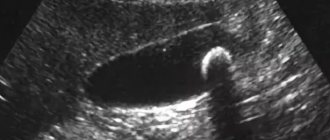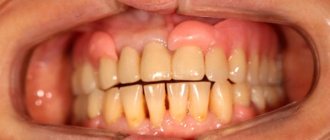The inflammatory process in the subgingival and subperiosteal jaw area with purulent formation (abscess) is called gumboil or periostitis. Its main cause is inflammation of the tooth root. A visual sign of the disease is a swollen cheek (a “bump” forms in the problem area).
Most of us prefer to treat flux on the gums at home, but periostitis is a fairly serious disease, the absence or untimely treatment of which poses a threat to the health of the entire body. In the article we will talk about the symptoms, causes of periostitis, and how to cure gumboil.
Flux: symptoms, causes of appearance
Characteristic symptoms of flux:
- swelling of the gums and face;
- pain in the area of the tooth that caused inflammation;
- enlargement and hardening of lymph nodes in the neck and head;
- general malaise: weakness, fever up to 38 degrees, headache.
Three stages of development of periostitis can be distinguished:
- at the first stage, pain occurs that bothers you when eating (due to contact with the site of inflammation);
- the gums swell, a “bump” appears, in which pus subsequently accumulates;
- swelling of various parts of the face (lips, cheeks, chin) occurs, the temperature may rise to 38 degrees, the pain radiates to the ear and visual organs.
The main reasons for the development of flux:
- advanced caries;
- complications after poorly performed treatment of pulpitis;
- gum injuries;
- hypothermia;
- jaw injuries;
- flux after tooth extraction;
- complications after flu or sore throat;
- inflammation of the gum pocket.
The following types of fluxes are distinguished:
- Ordinary. Pathogenic bacteria do not take part in the inflammatory process, but infiltration of the periosteum occurs.
- Fibrous. A chronic form of gumboil that develops as a result of exposure to irritants on the gum tissue. Thickening of the periosteum occurs.
- Purulent. It develops as a result of damage to the gums through which pathogenic bacteria penetrate. Often combined with purulent osteomyelitis.
- Ossifying. Develops as a result of prolonged irritating effects on the periosteum. Chronic illness.
- Serous. Periostitis with less pronounced symptoms develops quickly, but goes away within 2-3 days.
Development of the disease
Periostitis can be suspected by the unpleasant pain that constantly appears closer to the root of the tooth. The disease develops in several directions and often ends with a breakthrough of pus:
- primary flux - accompanied by swelling of the face on the side of appearance;
- inflammation spreads to nearby tissues, causing a purulent process;
- the gum pocket between the teeth and soft tissues becomes infected;
- There is extensive swelling of the face and severe swelling on the side of the diseased tooth.
While periostitis develops, it cannot be opened using additional methods. During the purulent process, the patient feels a tugging pain, his temperature rises, and painkillers do not work.
Inflammation should be treated with antibiotics prescribed by the dentist.
It is dangerous to treat flux at home due to the risk of complications. If the swelling becomes global, phlegmon may begin - the purulent contents of the tumor penetrate between the muscles of the face, into the neck, and can seep into the chest. As a result, sepsis begins, infected blood enters the brain and leads to coma or death.
If you open the abscess with a needle or other mechanical means, the patient will feel slight relief. But after some time the process will resume with renewed vigor .
Let's talk in more detail about the main types of fluxes.
Acute serous periostitis. As we wrote above, the inflammatory process occurs quickly and passes within a few days. It is characterized by severe swelling of the soft tissues. It is localized directly on the area with the diseased tooth, which is the main reason for the development of gumboil. The degree of inflammation depends on the structure of the vessels in the periosteum. The cause of the development of an acute form of serous flux can also be bruises and fractures. In this case, periostitis is called traumatic or post-traumatic. Most often it goes away on its own, but in some cases it can cause severe inflammation and the development of another type of flux - ossifying (fibrous growth).
Acute purulent periostitis. This type of gumboil is characterized by severe pain, which is often pulsating and spreads to the organs of vision and hearing, causing migraines. Pain is managed with medications and cold compresses. You should not heat the swelling site - this can lead to increased pain.
Purulent flux occurs with an increase in temperature to 37.5-38 degrees, the patient develops weakness and general malaise. It should be noted that the course of the disease depends on the location of the inflammation: in the lower jaw the process is more complicated.
The localization of inflammation depends on the location of the lesion:
- 1
Maxillary incisors - an inflammatory process on the upper lip and can spread to the nose. - 2
Maxillary canines and premolars - an inflammatory process in the periosteum.
- 3
Molars - an inflammatory process in the upper part of the cheeks.
- 4
Premolars - inflammation is localized in the lower part of the cheeks.
Chronic periostitis. The rarest form, which is usually localized in the periosteum of the lower jaw. In the chronic course of the disease, local inflammation is present, which does not change facial features. Characteristic symptoms are swelling in the mouth, enlargement of the periosteum, and lymph nodes. The development of this type of periostitis is a long process that takes from 4 to 8 months.
Do I need to treat burst flux?
Dentists note that it is necessary to treat gumboil. After all, the disease is dangerous because it leads to many complications, including phlegmon (purulent inflammation of the jaw tissue) and even sepsis - with this pathology, the infection spreads throughout the body.
So, why treat periostitis if the abscess has broken through:
- the pus will not come out completely - its remains will still be under the gum and can give rise to an inflammatory process with even worse consequences,
- the root cause of the flux has not been eliminated: the infection accumulated in the root canals will continue to provoke further suppuration if appropriate measures are not taken.
Flux diagnostics
The diagnosis of “periostitis” can only be made by a specialist. In order to identify the disease at an early stage, you will need to visit the dentist's office. Therefore, if such primary signs as hyperemia, accumulation of infiltrate, etc. are detected, we recommend immediately consulting a doctor for diagnosis. If an odontogenic type of periostitis develops in the mouth, then there is almost always a decayed tooth in the oral cavity, which is the cause of the pathogenic process.
Diagnosis is made using fluoroscopy. If the disease is in an acute stage, then it will not be possible to determine changes in the shape of the jaw using this research method, but it can be used to identify granulating periodontitis, which is a catalyst for the development of the inflammatory process.
Treatment of periostitis in 2022
This disease can only be treated by a dentist: no home remedies will get rid of infection, swelling and pain.
- The doctor conducts an examination, clarifies complaints and prescribes a computed tomography scan of the teeth.
- After receiving the diagnostic results, an accurate diagnosis is made, and the doctor chooses a treatment method.
- If periostitis is in the initial stage, then the tooth can be saved by eliminating the cause of inflammation (for example, clean the root canals, rinse them). In addition, antibacterial drugs, anti-inflammatory drugs, and painkillers are necessarily prescribed.
- If necessary, the doctor makes an incision in the gum near the causative tooth under local anesthesia to obtain exudate, installs drainage, and prescribes antiseptic rinses.
- In advanced stages, the tooth is removed.
Drug treatment is aimed at:
- individual selection of antibiotics to reduce inflammation and eliminate infection;
- Relieving swelling with anti-inflammatory drugs;
- pain relief.
Also, if necessary, immunomodulators and vitamin preparations are prescribed to strengthen the body.
Tooth flux - what to do?
The most popular search on the Internet: “how to get rid of gumboil”, “how to remove gumboil from a tooth”, “removing gumboil at home”. If you detect even the slightest signs of flux, we recommend seeking help from a doctor. Flux on the cheek is a pathological process that requires mandatory treatment, which will avoid serious complications, including conditions that threaten the patient’s life.
If signs of flux suddenly appear, before consulting a doctor, you can perform procedures that will help reduce swelling. But they should be considered as a temporary remedy to alleviate the patient’s condition.
How to rinse with flux? The following solutions can be used to relieve pain:
- Alcohol tincture of calendula. A teaspoon of the product is mixed in a glass of water. The resulting solution is used to rinse the mouth.
- Infusion of green tea and sage. To do this, use a teaspoon of sage and green tea in a glass of water. The herb is poured with boiling water and infused for 20-30 minutes. You should regularly rinse your mouth with the resulting solution.
- Mint and lemon balm leaves. The herb is poured with boiling water and left for 3-4 hours. The resulting infusion is used to rinse the mouth.
What to do if the flux bursts
As soon as a tumor is discovered on the gum, you should consult a dentist. The doctor prescribes appropriate treatment, which includes the use of antibiotics and anti-inflammatory rinses.
In some cases, flux develops very rapidly. Then the tissue tension becomes extreme, and the abscess can burst. This is an extremely unpleasant situation, however, you need to know what actions to take in this case.
At the moment when the tissue ruptures, most of the pus that has accumulated inside the flux comes out. The patient feels relief, as the pain almost completely disappears, and the abscess noticeably decreases in size. Due to the carelessness of patients who believe that this is the end of their fight against an abscess, serious complications often arise.
Why can our articles be trusted?
We make health information clear, accessible and relevant.
- All articles are checked by practicing doctors.
- We take scientific literature and the latest research as a basis.
- We publish detailed articles that answer all questions.
The fact is that a certain amount of pus remains in the flux cavity and pathogenic microorganisms continue to infect soft tissues.
Cheek swelling
If the cheek is swollen on the inside, then this phenomenon often indicates the presence of diseases of various types in the oral cavity.
After a patient’s flux has burst, there are actions that guarantee a quick recovery:
- you need to contact your dentist to have the cavity cleaned;
- After each meal, rinsing to prevent re-infection.
Flux - treatment in a dental clinic
The choice of treatment method for flux depends on the type of periostitis, its severity, and the individual characteristics of the body. In the acute form, the nerve is removed, the wound is opened and cleaned, treated with antiseptics, and antibiotics are prescribed.
To defeat purulent flux in an adult, they resort to a more comprehensive treatment program. In this case, additional procedures may be prescribed, as well as complex antibiotic therapy.
Regardless of the type of periostitis (excluding the chronic form of flux), a mandatory step is a course of antibiotics, which is selected individually. As a rule, with the right course of treatment, the flux goes away within 7-10 days (stable positive dynamics of recovery are recorded on days 3-5). In the chronic course of the disease, the tooth after gumboil is usually removed.
Let us remind you once again that by refusing professional help, you risk your health. Without the participation of a doctor, there is a high probability of the formation of a gingival fistula, the penetration of pus into nearby tissues, which causes the development of phlegmon.
Tooth abscess in children
The reasons for its appearance are most often associated with complicated caries. When pathogenic microorganisms, located in dental tissues, release acids that destroy enamel and cause inflammation. It is worth considering that in childhood there is still quite thin enamel and an extensive pulp chamber, and this contributes to the rapid penetration of infection inside, as well as a not yet fully formed immune system, which is not yet able to cope with the proliferation of bacteria.
Symptoms
The manifestation of pathology in children can be expressed by the following signs:
- Raising the temperature to 38 - 39 and above;
- Enlargement of the submandibular lymph nodes and cervical nodes;
- Refusal to eat;
- Moodiness;
- The appearance of toothache.
- The occurrence of edema.
After the examination, the doctor begins to treat the tooth abscess by opening it so that all the pus can come out. After this, the child is prescribed rinses to prevent the onset of inflammation and antibiotics. If the measures taken do not help, the baby tooth is removed. If necessary, the dentist will prescribe symptomatic therapy in the form of antipyretic and analgesic devices. To strengthen the body's immune defense, it is recommended to take vitamin supplements during the recovery stage.
If you do not have the opportunity to urgently see a doctor, then this information on how to relieve gumboil pain at home will be useful. Rinsing with decoctions of medicinal plants such as sage, St. John's wort, yarrow, calamus root or strong green tea produces primary disinfection, relieves swelling and slightly reduces pain. This temporary measure will not relieve you of the disease. Disinfection will help temporarily delay negative consequences. Everyone knows what to do if an adult’s temperature rises above 38 during flux: take an antipyretic and consult a doctor. Exacerbations will be repeated until the flux goes away.
How to treat flux in a child?
Quite often, parents ignore the fact that they have baby teeth affected by caries, reassuring themselves that permanent teeth will soon grow in their place. However, an infected gum can cause gumboil to develop. The child’s body does not always react to periostitis with an elevated temperature, and the only symptom may be minor pain, which is not given any importance. The immunity of children is weaker than that of adults, so the disease progresses quickly.
In order to prevent complications, it is necessary to begin treatment at the first sign - clean the canal, close the hole in the tooth with a filling.
Is it possible to pierce flux with a needle at home?
Many self-medication methods are extreme, but this does not make them more effective. Some patients are confident that they can pierce the flux themselves with a regular needle, even at home.
After this, they use various rinses and lotions. However, positive results after such manipulations are extremely rare.
Under no circumstances should you violate the integrity of the gums or skin on your own. Such operations can have extremely negative consequences:
- worsening of the inflammatory process;
- an increase in the amount of pus in the abscess;
- pus can penetrate into spongy and soft tissues;
- may develop as a complication ;
- Cellulitis without proper treatment develops into sepsis.
FAQ:
How to rinse the flux to make it break out?
As we wrote above, any procedures cannot replace consultation and treatment in a dental clinic. Before visiting a doctor, in order to alleviate the condition and reduce swelling (edema), you can rinse your mouth with various antiseptic and antimicrobial agents, for example, chlorhexidine. Additionally, you can use sodium saline solution, sage decoction, and calendula tincture.
The flux has burst - what to do?
If the flux has burst, the time before visiting the doctor can be used to carry out simple procedures on your own. First of all, you should rinse your mouth with clean water at room temperature. You can do this using a soda solution - to do this, you need to dissolve a teaspoon of soda in a glass of warm clean water. It is advisable not to eat before being examined by a doctor.
What to do to prevent flux?
The best prevention of flux is regular hygiene procedures in the oral cavity and timely treatment of foci of chronic infection.
Do not forget that gumboil may not go away on its own, turning into a chronic disease, and given that it poses a serious danger to human health, we recommend that you do not hesitate to contact a dental clinic. Only here is reliable diagnosis and effective treatment possible. Be healthy!
Methods for treating flux
It is impossible to cure gumboil at home. Traditional medicine recipes only help to slightly reduce the pain or help the abscess burst. But this allows only to alleviate the patient’s condition for a while. Complete treatment can only be provided by an experienced specialist, and in the presence of flux, not only the intervention of a dentist, but also, first of all, a surgeon will be required. Let's look at the sequence of actions when treating periostitis:
- First of all, the dentist examines the patient’s oral cavity, identifying the presence of swelling of the gums and a purulent capsule.
- The doctor sends the patient for an x-ray, which makes it possible to see the condition of the dental canals and pulp.
- After this, the patient is sent to see a surgeon, who makes an incision in the gum near the tooth where the flux has formed, cleans out the pus, treats the wound and installs drainage in the form of a small piece of gum so that the incision does not have time to quickly heal and so that the inflammatory fluid comes out.
- A few days later, you need to visit the dentist again, who will remove the drainage and treat the wound with an antiseptic drug.
- After the incision has healed and the gum swelling has subsided, the dentist can begin treating the tooth, if it can be saved. To do this, the pulp is removed, the canals are thoroughly cleaned and sealed.
- If a tooth is severely damaged and cannot be cured, it is removed.
Flux on the gums: treatment, causes
From this article you will learn:
- why does flux (abscess) occur?
- abscess on the gum: treatment, antibiotics,
- opening of a gum abscess: video.
Flux on the gum is a swelling of the gums associated with the development of purulent inflammation. Dentists do not use the term gumboil or abscess (only patients say so), but use terms such as “gingival abscess” or “periostitis”.
Flux on the gum: photo
Flux on the gums: causes
The situation when a person’s gums are swollen can be associated mainly with three factors: the lack of timely treatment of caries and pulpitis, poor-quality treatment of pulpitis and periodontitis in the past, as well as the presence of concomitant inflammation of the gums.
- Untreated caries and pulpitis - if caries is not treated for a long time, the infection from the carious cavity penetrates into the dental pulp, where inflammation develops. Pulpitis is characterized by acute or aching spontaneous pain in the tooth. If at this stage you also do not go to the dentist, then the inflammation progresses and the infection goes beyond the dental pulp - into the tissue surrounding the tooth. As a result, purulent inflammation develops around the tops of the roots of such a tooth - Periodontitis (Fig. 4a).
With periodontitis, a so-called periodontal abscess (in common parlance – a purulent sac) forms in the area of the root apex. When inflammation is active, intensive formation of pus occurs, which leads to the release of pus under the mucous membrane of the gums (Fig. 4 b). After the pus releases into the soft tissues, a person immediately feels that his gums are swollen, i.e. flux has formed. As a rule, flux is combined with swelling of the soft tissues of the face.
Case from practice: development of gumboil in the upper jaw → In Fig. 5 you can see a patient who came to the dentist with complaints of swelling of the cheek and gums. An external examination reveals facial asymmetry due to swelling, as well as painful hardening of the soft tissues of the cheek (shown by arrows). → When examined in the oral cavity (Fig. 6), we see that swelling of the gums is determined along the transitional fold (shown by white arrows), and in the projection of the swelling there is a half-destroyed tooth (shown by a black arrow). → In Fig. 7 we see an x-ray of the causative tooth: there is a darkening in the area of the root apex, which indicates the presence of a periodontal abscess.
Poorly sealed root canals - a periodontal abscess at the apex of the tooth roots can form not only in the absence of timely treatment of caries and pulpitis, but also in the case of poor-quality root canal treatment. It is customary to fill root canals in the treatment of pulpitis, periodontitis, and in preparing teeth for prosthetics.
If the root canals are not filled to the apex of the root, then conditions for the development of infection are created in the unfilled part of the root canal. In this area, the pathogenic microflora gradually multiplies and then spreads beyond the boundaries of the tooth. As a result, in the area of the root tips, the canals of which were poorly sealed, a focus of purulent inflammation (periodontal abscess) appears.
Analysis of the quality of root canal filling using radiographs –
- In Fig. 8-9 you can see poorly treated root canals. The unfilled parts of the canals are marked with white arrows. The focus of purulent inflammation (periodontal abscess) on x-ray looks like a pronounced darkening at the root apex (limited by black arrows).
- In Fig. 10 you can see how well-filled root canals look on an x-ray. Black arrows mark the apexes of the roots of the three lower incisors. Please note that each of the three teeth is filled to the top of the root.
Swelling of the gums during exacerbation of periodontitis - with periodontitis, the tooth-gingival attachment is destroyed between the tooth root and the gum, and thus periodontal pockets appear (Fig. 11). On the surface of the root in such a periodontal pocket there are almost always hard subgingival dental deposits, and the pocket itself is filled with granulations and pus. If the pocket is deep enough, the outflow of pus from it may be impaired. In this case, a swelling or fistula occurs in the projection of the pocket on the gum.
In Fig. 12 you can see a periodontal abscess on the gum in the projection of the upper central incisor. Probing of this tooth revealed a periodontal pocket of about 8 mm. On the x-ray of this tooth (Fig. 13) we can see that the depth of the pocket (depth of bone destruction) in the interdental space is more than 2/3 of the length of the root.











